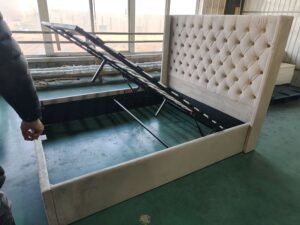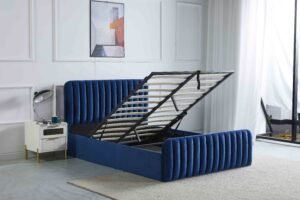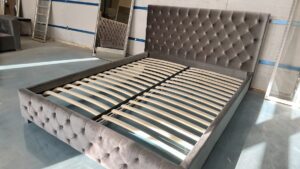What role do trade shows play in sourcing mattresses from China?
Sourcing mattresses online can feel like a gamble. You can't test the quality, and building trust over email is hard. Trade shows are the solution to this uncertainty.
Trade shows are essential for sourcing mattresses in China. They allow you to meet suppliers face-to-face, test product quality directly, build real relationships, and discover new trends. This personal connection is key to finding a trustworthy manufacturing partner and avoiding costly import mistakes.
I've been in this business for a long time, and I can tell you that nothing beats meeting a supplier in person. I attend the Furniture China trade show every year, and it’s where I build the strongest partnerships. You can see the materials, feel the firmness, and talk directly to the people who will be making your products. It replaces guesswork with confidence. This direct approach is the best way to navigate the sourcing process. Let's dive deeper into some of the common questions my clients, like Karim from Australia, ask when they start sourcing mattresses from China.
Are mattresses made in China good?
You hear stories about poor quality and worry about your investment. Will the mattresses you order last? I can help you understand how to identify high-quality Chinese manufacturers.
Yes, high-quality mattresses are definitely made in China. The quality depends entirely on the manufacturer you choose. Reputable factories use premium materials like high-density foam and strong steel springs to create durable, comfortable mattresses that last.
The difference between a good mattress and a bad one comes down to what's inside. I've seen firsthand how some factories cut corners. They might use a nice fabric on the outside, but fill it with low-density foam that sags after a few months. Or they use thin metal wire for the springs, which can't provide proper support for very long.
At my factory, we focus on quality materials. We use high-density foam that bounces back perfectly even after being compressed for shipping. Our pocket spring mattresses use thick, high-quality metal wire that provides support for many years. We also use eco-friendly glue, so the mattresses don't have a strong chemical smell. These are the details you should look for.
Quality Checklist: Good vs. Bad Chinese Mattresses
| Feature | High-Quality Supplier | Low-Quality Supplier |
|---|---|---|
| Foam | High-density, resilient foam | Low-density foam that sags |
| Springs | Thick, durable metal wire | Thin wire that loses support |
| Glue | Eco-friendly, low odor | Strong chemical smell |
| Fabric | Durable, well-stitched covers | Thin fabric, poor stitching |
Where are mattresses imported from?
The global supply chain can seem complex. You wonder where most businesses get their mattresses from. Understanding the major players helps you make smarter sourcing decisions for your market.
While mattresses are made globally, China is one of the world's largest exporters. Other major players include Vietnam, Mexico, and Poland. Your location often influences the best country to source from, but China remains a top choice for many businesses worldwide.
As a manufacturer based in China, I see the global demand every day. We regularly ship containers to furniture retailers and wholesalers all over the world. Our main markets include the USA, UK, Canada, Germany, Australia, and France. We understand the different standards and preferences for each of these regions. For example, a client like Karim in Australia might need different certifications than a client in Germany.
While China is a manufacturing giant, other countries have grown their mattress production too. Vietnam has become a popular alternative for some American companies. Mexico is a key supplier for the U.S. due to its proximity. However, China's vast infrastructure, material supply chains, and production experience keep it a leading choice for businesses seeking a balance of quality, cost, and variety. It's a very established and reliable supply chain.
Who is the largest mattress manufacturer in the world?
You see big brand names and wonder who makes their products. Does working with the biggest factory guarantee the best results? Let's look at what "largest" really means.
Publicly traded companies like Tempur Sealy International often lead in revenue. However, many massive private-label manufacturers in China produce enormous volumes for well-known brands globally. The "best" partner isn't always the biggest.
Many of the famous mattress brands you see in stores don't own their factories. They partner with manufacturers like me to produce mattresses to their specifications. We have collaborated with major brands, which shows our ability to meet high standards for quality and production capacity.
However, being the "largest" isn't the most important factor for a buyer like Karim. He needs a supplier who is reliable, flexible, and easy to communicate with. A mid-sized factory like ours, with a dedicated team of 120 professionals, can offer more personalized service. For example, we offer a rapid 7-day turnaround for new samples. This speed and flexibility can be more valuable than just pure size. The key is to find a factory that is the right fit for your business needs, not just the biggest one on paper.
Who trades the most with China?
You want to source from China but need reassurance. Knowing that many others do it successfully provides confidence. You are tapping into a proven, massive global trade network.
China's top trading partners include the ASEAN countries, the European Union, and the United States. These economic giants import billions of dollars worth of goods, including furniture and mattresses, establishing reliable and efficient trade routes.
The scale of trade is enormous. This means that the logistics, payment systems, and regulations for shipping goods from China to major markets are very well-established. My factory is part of this global flow of goods every day. We ship to clients in North America, Europe, and Australia, so we have deep experience with the specific requirements for each region.
For a business owner like Karim, this is a huge advantage. It means we can offer services like door-to-door delivery because we work with experienced shipping partners. We understand the customs paperwork for Australia and can help avoid delays. When you source from China, you are not figuring things out for the first time. You are joining a well-traveled path that millions of businesses rely on, making the process smoother and more predictable. This established network minimizes risks and helps you get your products without surprises.
How to know if a mattress is quality?
You can't see inside a mattress, so how can you judge its quality? Avoiding customer complaints is crucial. I'll show you the specific things to check to ensure you're buying a great product.
Look at the core components. A quality mattress has high-density foam that doesn't sag, a high count of thick steel coils for support, and durable stitching. Also, check for certifications and make sure there is no strong chemical odor.
When I meet clients at trade shows, I always show them cross-sections of our mattresses. It's the best way to prove quality. Here is what I tell them to look for.
Foam Quality
Low-density foam is a common problem. It feels okay at first but can develop permanent body impressions. We use high-quality, dense foam that recovers its shape, even after being compressed in a box for weeks. This directly addresses the compression issues some buyers face.
Spring System
For innerspring or hybrid mattresses, the steel coils are the core. Look for a high coil count and, more importantly, a thick wire gauge. Thin wires bend easily and will stop providing support. Our springs are made from strong steel designed to last for years.
Adhesives and Fabric
The glue used to hold the layers together matters. We use an eco-friendly adhesive that is safe and doesn't have a strong chemical smell. The outer fabric should also feel durable and have clean, tight stitching around the edges.
What is the most durable mattress type?
You need products that last to protect your brand's reputation. Customer complaints about sagging are costly. Let’s explore which mattress types offer the best long-term durability.
Latex and mattresses made with high-density memory foam are typically the most durable options. A well-built innerspring mattress that uses thick steel coils can also be extremely durable, often lasting for a decade or more.
Durability really comes down to the quality of the materials inside, not just the type of mattress. However, some types have natural advantages. I manufacture several types, and here's my perspective on their longevity.
Innerspring Mattresses
The durability of an innerspring mattress is all about the steel. A mattress with a strong, high-gauge coil system will resist sagging and provide consistent support for years. This is a traditional and very reliable choice when made correctly.
Foam Mattresses
For all-foam mattresses, density is everything. High-density memory foam or polyfoam is much more resistant to body impressions and softening over time than low-density foams. A dense foam core is a great sign of a durable product.
Hybrid Mattresses
Hybrids combine coils and foam. Their durability depends on the quality of both parts. A hybrid with a strong coil base and high-density comfort foams can offer the best of both worlds: the responsive support of springs and the durable comfort of quality foam.
How thick should a mattress be?
You see mattresses in all different heights. Does thickness actually matter for quality? Choosing the right profile affects comfort, support, and shipping costs, so it's an important decision.
A good adult mattress should be at least 10 inches (25 cm) thick to provide a proper balance of comfort and support layers. Mattresses that are 12 to 14 inches thick are often considered premium or luxury.
Mattress thickness, or "profile," is not just for looks. A thicker mattress allows for more layers of foam and coils, which creates a more sophisticated feel and better support. A very thin mattress simply doesn't have enough room for a robust support core and a plush comfort layer.
Here's a simple guide I share with my clients:
Understanding Mattress Thickness
| Thickness | Best For | Description |
|---|---|---|
| Under 8 inches | Kids, bunk beds, temporary use | Basic construction, minimal layers. Not ideal for most adults. |
| 8-12 inches | Most adults | The sweet spot. Provides a good balance of support and comfort for average-weight sleepers. |
| 12+ inches | All sleepers, including heavier individuals | Considered luxury. Allows for thick comfort layers, providing excellent pressure relief. |
For a retailer like Karim, offering a 10-inch and a 12-inch option is a great strategy. It covers the main needs of the market and provides a clear good-better-best choice for his customers.
Conclusion
Trade shows are vital for finding quality mattress suppliers in China. Meeting face-to-face allows you to verify quality, build trust, and create partnerships that help your business succeed.




